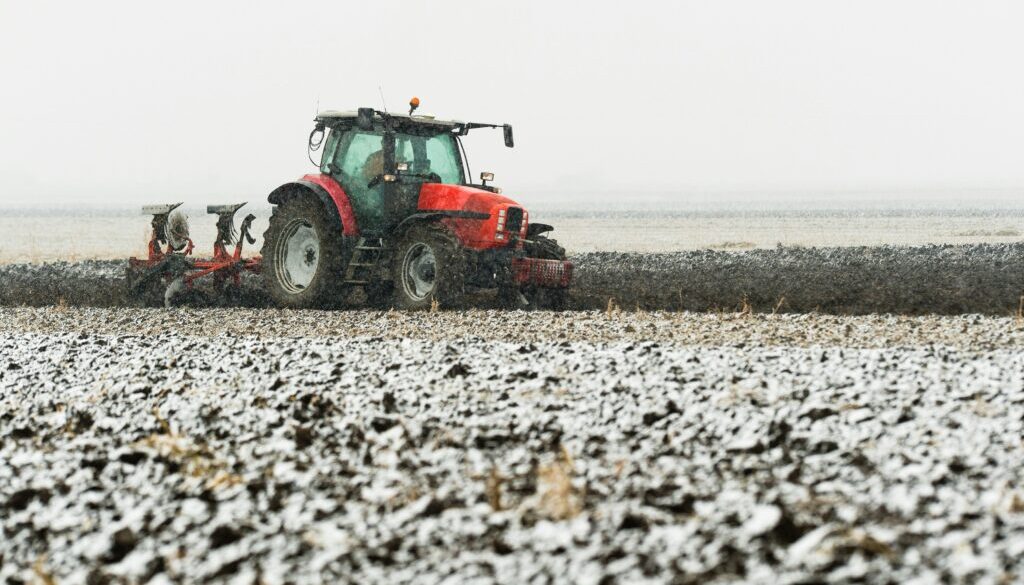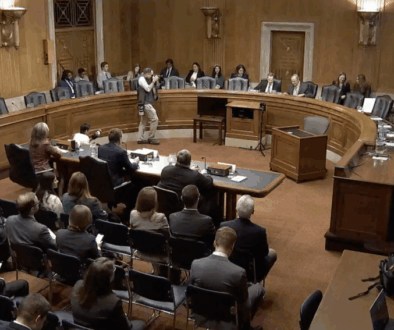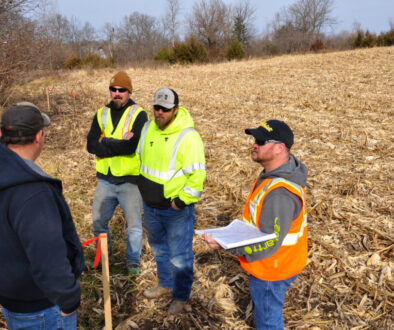“We need it” – Debate over dicamba herbicide in hands of Trump’s EPA
By Richard Mertens
Patsy Hopper dreamed of a home in the country with a garden and lots of trees. What she didn’t count on were the herbicides that would come drifting in, year after year, from the farmland around her, killing vegetables in her garden and wildflowers in the ditches and curling the leaves of the trees she had planted.
“I have a lot of trees dying,” said Hopper, who lives five miles from Urbana, Illinois. “I don’t think they’ll survive.”
Hopper isn’t alone. A popular weed killer called dicamba, which is used in growing crops such as soybeans and cotton, has in recent years become notorious for inflicting widespread damage well beyond the fields where it is sprayed. Dicamba drift, as it’s called, has harmed other farmers’ crops, as well as vegetable gardens, orchards, and natural vegetation. The damage has spawned lawsuits and caused hard feelings in rural communities. It even led to the killing of an Arkansas farmer in 2016.
Farmers have used dicamba to kill weeds since the 1960s. But new formulations developed by Monsanto, BASF and Syngenta to be used with genetically engineered crops tolerant of dicamba wreaked havoc when they came into use roughly 8 years ago, largely because they encouraged farmers to spray dicamba after their crops sprouted. These formulations are marketed to be used ‘over the top’ (OTT) because they are sprayed on top of growing crops, killing weeds but not the genetically engineered crops.
The warm weather that typically accompanies crop growth makes dicamba more prone to volatilize and drift. And since the rollout of the new dicamba products and the OTT use, thousands of incidents of “off-target” damage have been recorded across many states, mostly in the South and Midwest. Millions of acres of soybeans have been damaged.
Last year, a US court banned the use of the dicamba OTT weed killers. Now, as farmers prepare for their next planting season, the US Environmental Protection Agency (EPA) is again considering whether to grant approval to dicamba products used with dicamba-tolerant crops. The issue has divided rural communities and fostered heated debate.
Opponents want the use of OTT dicamba halted permanently. But many farmers say they need it. Agrochemical companies developed the dicamba system – new formulations of the herbicide to be used with crops engineered to tolerate it– as an alternative to Monsanto’s widely used chemical-crop system built around the weed killer glyphosate. Millions of acres now sprout weeds resistant to glyphosate, and many farmers say dicamba is among just a few herbicides that still work on the most troublesome weeds in their fields.
“It (dicamba) definitely is a big deal,” said Sam Whitaker, whose family grows rice, soybeans and cotton in Arkansas. “We need it.”
Uncertainty under Trump
Dicamba’s fate rests with an agency that two federal courts and its own inspector general rebuked for undermining the approval process and understating dicamba’s risks when it approved the herbicide during the first Trump administration.
Since then, the new Trump administration has fired the EPA’s inspector general, threatened to dismiss more than 1,000 other employees, and vowed to cut regulations.
“All bets are off under Trump,” said Bill Freese, science director at the Center for Food Safety, an advocacy group that has been one of the most vigorous opponents of the new dicamba uses. The Biden administration showed “at least” some concern for the damage dicamba could cause, he said. “I don’t know if that will happen under Trump.”
Concern over herbicides has often focused on their threat to human health. Glyphosate, the main ingredient in Roundup and other herbicide products, has been at the center of a heated debate in both courtrooms and scientific journals over whether it causes cancer. At the same time, the damage that herbicides cause to the land, including neighboring crops and natural vegetation, is coming under growing scrutiny.
Last year, for example, a study conducted for the Illinois Department of Natural Resources found herbicides in tree leaves at nearly all of the 102 natural areas that researchers visited up and down the state. A longer-term study by Prairie Rivers Network, an advocacy group in Illinois, found damage to trees and other vegetation six years in a row in some areas. In both studies herbicides were at times found far from the nearest fields.
“The way we are currently farming, this chemically intensive process of controlling weeds is not going to end well,” said Kim Erndt-Pitcher, director of ecological health at Prairie Rivers Network. “We’re going to get more and more resistance and more and more chemicals out into the landscape.”
One of the oldest and most popular herbicides, 2,4-D, has also been blamed for off-target damage, including the killing of grape vines in vineyards and apple and peach trees in orchards. The Illinois study found that 2,4-D was a major cause of tree damage in the state.
“Dicamba is the thing that got people thinking about it, but the broad range of other things is pretty surprising,” said Thomas Benson, a wildlife ecologist at the University of Illinois Urbana-Champaign and an author of the study.
A fraught history
Dicamba brings with it an especially fraught history. Farmers have long known that dicamba had a tendency to vaporize in warm weather – turning from liquid to gas and, depending on the wind, to drift far from where it had been applied.
Critics warned that using dicamba in early summer would cause problems, and those warnings were confirmed. A 2021 EPA report blamed dicamba for 1,400 reports of damage in 2017, 3,000 in 2018, 3,300 in 2019, and 3,461 in 2021. Most involved damage to crops that lacked the dicamba-resistant gene. But there was also damage to vegetables, sugar beets, sweet potatoes, cotton, orchards, vineyards, cemeteries, city parks, natural areas and wildlife refuges.
State and federal regulatory agencies have not been indifferent to dicamba’s shortcomings. Over the years they have tightened the rules governing its use, often by limiting the dates by which farmers may apply it. Other rules forbid farmers to apply it during temperature inversions or on windy days. The companies that make it have introduced formulations designed to reduce volatilization. When the EPA last approved OTT dicamba in 2020, it said “with 90% confidence” that there would be “no offsite movement of dicamba.” The next year produced more complaints than ever.
This disconnect has raised questions not only about the EPA’s objectivity but about whether farmers can – or are willing to – follow the rules when applying herbicides.
A study of air-borne dicamba in eastern Arkansas in 2020 and 2021 regularly detected the herbicide later in the season than farmers were allowed to use it.
“Sometimes you feel like you can’t win,” said Nick Harre, a corn and soybean farmer in Nashville, Ill., who said he understood the predicament of his fellow farmers. “Either the ground is wet or the wind is blowing. Those weed are going to keep growing and steal your yield. I understand the frustration, not getting out there and being able to apply it.”
In the past few years, several states have reported declines in the number of herbicide-damage complaints. In Illinois, for example, complaints to the state Department of Agriculture dropped from a high of 971 in 2019 to a low of 233 by 2023.
It is not clear why complaints have dropped. Some say farmers and their contractors may have come to understand dicamba’s risks better and are being more careful when they apply it. Others, like Harre, have given up on dicamba and switched reluctantly to another herbicide. “There were too many headaches getting it applied,” he said.
But the drop in complaints may also be due to underreporting and what some call “dicamba fatigue.” The weed scientists who met with the EPA in 2022 described “rampant underreporting of dicamba issues due to the desire for preservation of neighbor relationships, fear of losing insurance money, questions of accountability, and general fatigue with the process and lack of resolution in the past.” Indeed, in 2021 the EPA itself estimated that reports of dicamba damage understated the actual damage “by a factor of 25.”
The new dicamba application now with the EPA would set stricter limits on its OTT use to reduce dicamba’s use during hot weather, when it is most prone to drift.
Those most concerned about off-target damage doubt that these new limits will work. Even if farmers follow the rules, they say, most vegetables, trees and other natural vegetation have leafed out well before the proposed cut-off dates and will be vulnerable to herbicide damage.
They note that climate change is also making winters shorter, moving up planting times and bringing summer-like temperatures earlier in the season. Soybeans without the dicamba resistant gene will remain vulnerable.
The new proposed rules “won’t make a hill of beans,” Patsy Hopper said.
Matt Tiffany, a farmer in Redwood Falls, Minn., said he turned to dicamba as glyphosate lost its effectiveness. “It gives us better control,” he said. But he needs to be careful with it, he said. He pays close attention to what his neighbors are doing. “If they have dicamba-tolerant soybeans, I use dicamba,” he said. If they don’t, he uses something else, like 2,4-D. “I don’t want to have problems with my neighbors,” he said.
A decision on dicamba is not expected until after this year’s growing season.
(Featured photo by Getty Images for Unsplash +.)



